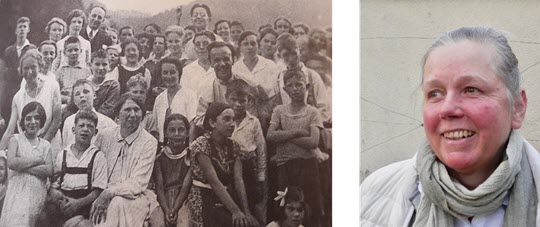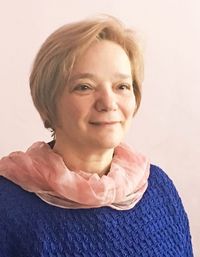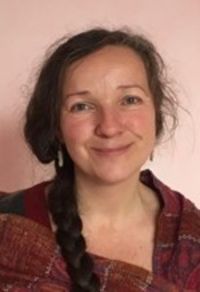2021 - Colourful variety of eurythmy therapy /Eurythmietherapie
Every two month we present eurythmy therapy work from different countries and areas of work. In this way we celebrate the abundance of eurythmy therapy.
In this second part we focus on the role of eurythmy therapy in special needs education. Enjoy this glimpse into a therapy session in Armenia.
- The Beginnings of Eurythmy Therapy in Curative Education and Social Therapy (Wilburg Keller Roth).
- Hopeful moments from curative education in Armenia (Irina Sorokina)
- Three experiences with eurythmy therapy in curative homes (Marianna Bauko)
The Beginnings of Eurythmy Therapy in Curative Education and Social Therapy
Soon after its foundation in 1921, the clinical-therapeutic institute in Arlesheim began admitting children with behavioural problems and developmental disorders, by 1924 in the Sonnenhof, a curative home in Arlesheim. At the same time, three young curative educators founded the home on the Lauenstein near Jena. At the Stuttgart Waldorf School, children with developmental delays were admitted and treated in a special remedial class as early as 1919. Eurythmy therapy for children with special needs developed in these centres from the collaboration of the teachers and the first eurythmists with Rudolf Steiner. Since then eurythmy therapy and special needs education has spread to all continents of the world with about 650 anthroposophical curative education and social therapy institutions in over 50 countries.
Nine-year-old Sandroe, whose head was constricted by a forceps birth and whose development was delayed after a sunstroke when he was about nine months old, was one of the first children to be brought to Arlesheim for treatment. Eurythmy therapy was initially performed here by two young doctors, Julia Bort and Margarete Kirchner-Bockholt. We owe the most beautiful description and explanation of a Eurythmy Therapy sequence by Rudolf Steiner himself to the discussion of Sandroe during the curative education course in 1924: "[He] makes R and L. R is a turning, something is turning round, is revolving. There at once you have mobility. […] [L is] the sound that signifies yielding or compliance, adapting oneself to fall in with something. And that is what the boy’s organism needs: to be made pliant and supple, so that it will be ready to adapt itself. […] we have to see that the exhalation process is stimulated as much as possible and that he boy himself participates in it. This happens in M. This is the exhalation sound[…]. And N provides the tendency to lead back into what belongs to the intellect. We shall have for this boy R, L, M, N. As you see, once we have a comprehensive picture of the child’s condition, we know what we have to do.For this we must, of course, know, first of all, the true nature of each sound, and be absolutely at home in eurythmy; then, we must on the other hand have also the ability to look with clarity and discernment into the bodily organisation of the child. Both are things that can be learned…"
It is often touching to experience how in eurythmy and eurythmy therapy behavioural abnormalities such as agonising restlessness, shyness and aggressiveness, but also physical deformities recede and the healthy and harmonious human being becomes visible. In the physical and mental one-sidedness, however, individual sound qualities can also appear particularly clearly, such as U in Sandroe or R in Robert. In this way, the people we care for become our teachers, just like Sandroe, who is said to have said of himself throughout his life: "I am the first healing pedagogue".

Further links on the subject of eurythmy therapy in curative education:
- www.freunde-waldorf.de
- www.anthroposophie.ch/de/heilpaedagogik-sozialtherapie
- Selg, P. (2004): The Angel above the Lauenstein. Siegfried Pickert, Ita Wegmann and curative education. Dornach
- Strohschein, A. (1967): The emergence of anthroposophical curative education. In: Krück von Poturzyn, M.J. (ed.): We experienced Rudolf Steiner. Memoirs of his pupils. (3rd ed.) Stuttgart, pp. 211-226.
- Niklaus Hottinger: Sonnenhof Arlesheim und seine Geschichte von 1924 bis heute, ed. by Sonnenhof Arlesheim and Edition Text und Media 2016, hardback, 330 pages, 180 illustrations, Fr. 35.- (plus postage).
- Wilhelm Uhlenhoff, Die Kinder des heilpädagogischen Kurses, Verlag freies Geistesleben.
- Julia Bort, Curative Eurythmy with Children in Need of Soul Care.
- Margarete Kirchner Bockholt, Basic Elements of Curative Eurythmy
- Curative Eurythmy and Hygienic Eurythmy, Persephone Series, Publishing House at the Goetheanum
- Rudolf Steiner, GA 317, 6th and 7th lecture from 1 and 2.7.1924
Hopeful moments from curative education in Armenia
Armenia is a country at the foothills of Mount Ararat. The shape of Armenia is reminiscent of the profile of a girl looking west. This is all that remains of the once great ancient Armenia from the Mediterranean to the Caspian Sea. Armenia is older than Rome. It was the first state to adopt Christianity as the state religion.
After troubled times of war in the past, Armenia is on the verge of losing its statehood, on the threshold of a new war.
Since the collapse of the Soviet Union, the well-known "uninvited guests" have been working tirelessly to destroy the country from within. Thus, both in war and in peace, the latest world technologies are tested here.
In the hard post-Soviet times, the first and so far only Waldorf school was founded in Armenia. Even in hard times for the country, our work was never interrupted.
Our school is 27 years old. The curative education group has been around for 16 years. The group has a strong base of therapies and works with the only anthroposophical doctor in Yerevan (the capital of Armenia) and with the only rhythmic massage therapist in the country. The aim of the group is to integrate the Special Educational Needs (SEN) children as much as possible into the general educational process. Each child receives their own individual timetable: In certain classes they sit alone or with a tutor, in others they are taken out for individual lessons or therapy.
Most class teachers open the doors of the class for the SEN child. And there is something of therapy in that. Usually a kind of "guardian" from the class quickly appears next to the SEN child.
The children participate in all classroom activities. They also perform plays with them, there are open classes for parents, concerts, excursions with field trips and meaningful work. Parents are often involved in the work of the group. The children's obvious successes, their transformations are always the result of our joint work.
The group started to form when the school was 12 years old. The teachers working in the school began to rally around the adopted SEN children. Parents and homeopathic doctors working with children also approached the school with their educational questions.
A social organisation "Mairi" was founded for children coming from outside the school. In the eighth year, the group was spun off into a separate social therapy centre, Mairi.
In the fifteenth year, the school's lead curative education specialist for working with pre-school children moved her work to the "Shoghik" centre for healthy childhood and curative education.
In the beginning we had no place to work: We worked in spare classrooms or in the corridors of the school. Now we have rented three small rooms in front of the school building for our work. We call it "The House". In the eurythmy studio I work with older children - both with young people and with adults.
I work as a eurythmy teacher in a school with pupils form class 1-12. I have worked in the therapeutic and pedagogical group since its foundation. I teach in an educational workshop. I supervise the work of eurythmy education in Armenia.
The participants of the short film are pupils of the Yerevan Aregnazan Waldorf Education Complex. As a general education school, it has been integrating children with special educational needs into the general educational process within an appropriate framework since 1994. The work of an eurythmy therapist is part of the collegial work of specialists around these children.
Special thanks to the author of the film, Anush Martirosyan, student of the pedagogical and eurythmy seminar, without whom the film would not have been made. Irina Sorokina.

Three Experiences of Eurythmy Therapy in Curative Homes
“If we treat people as if they were all they could be,
we make them more than they are;
but if we treat people as if they are actually what they are,
we make them less than they are.”
Johann W. von Goethe
I worked and experienced curative homes on and off at different stages of my life. My first encounter with Eurythmy Therapy was in Camphill Hemel en Aarde, in Hermanus, South Africa. I was living there as a young co worker sharing life with the children in one of the houses, teaching Eurythmy and helping in the Camphill School.
The Camphill School had a visiting Eurythmy Therapist who came twice a year and worked intensively for a few weeks with a small number of children. When she came to take them, it felt like they went on a magical journey through the gardens of blossoming flowers, bushes, trees and the vegetable patches towards the Eurythmy room. I felt it was so healing for these children to be held and lead from the outer nature, the etheric realm moving into their own life forces through the Eurythmy gestures.
The whole environment with its Paradise like nature world, the strong supporting, holding quality of the rhythm of the days and the year through meaningful daily tasks and festivals, one to one individual support gave everybody a healthy life sheath. Eurythmy Therapy could bring into that the healing forming, cosmic forces.
I had a chance to get to know most of the children, to have a glimpse or a strong feeling even if only for a moment who they really were. They were also able to show me like in a mirror who I really was. When the multiple layers of petals of protection are falling away and we see a naked soul without the burden of addictions, aggression, obsessions, fears, then the spirit is asking for help.
I did want to help, I wanted to have the tools and knowledge to do it through Eurythmy Therapy.
I decided to do the therapeutic training.
Years later I had my second encounter with Eurythmy Therapy in a care home, in Sonnenhof, Arlesheim, Switzerland when I did my six months placement. This time I could work for the first time as Eurythmy Therapist with children with special needs, who had different ages, backgrounds, difficulties. I met children there with severe physical needs, but with amazing thirst for life, for joy, for learning. Also children with perfect, beautiful physical bodies who found it difficult to create connection with themselves and the world around.
It is such a wonderful, exciting work to help an individual to gain consciousness in his body through movement, through the rhythms feel the pulse of life and through the Eurythmy gestures work with the cosmic, forming forces of nature. Two full time Eurythmy therapists were employed there. The children were taken out two-three times weekly from different lessons. Usually, a whole therapeutic team with anthroposophic doctor, teacher, house parent and various therapists were supporting each child so that their needs are met and they can reach their true potential in this life and the future.
My third encounter was with “Eurythmy Therapy in care homes “in Garvald West Linton and Garvald Centre Edinburgh in Scotland where I worked for ten years.
This time I had a chance to get to know adults with special needs. Some of the residents lived almost their whole lives in Garvald West Linton, they have been staying since their childhood when Garvald was a school. Since these children grew up the whole place has transformed into a residential care home, with workshops. Others lived alone in supported accommodations and found community and meaningful activities in the day service workshops.
Most people had several blocks of Eurythmy Therapy sessions during their stay, embedded in their weekly rhythm. For most of them Eurythmy came very naturally and they moved effortlessly connecting to the forming forces, tapping into this realm by creating the gestures ensouled, artistically or imitating the movements with the joy and beauty of a child.
I realized over the years how powerful the healing effect of a community could be on an individual s life. It has very different qualities depending on the environment, ( nature, farm, city life) , what skills the individuals have, ( crafts, arts, music, poetry, dance…), what individual, and unique human qualities people bring while sharing their life. Eurythmy Therapy adds to all these qualities, as a nourishment for body, soul and spirit. The Therapeutic Eurythmy work today is probably more important than ever in these chaotic, uncertain, isolating, fearful times, where real human connections fade away into virtual reality.
Not only adults and children with learning difficulties, but all of us with our unique incarnation processes are differently (tighter or looser) connected to our temple, our physical body, the earthly realm. This connection gives us the ability to bring consciousness into our deeds, to make responsible decisions in our life and helps us stay connected to the spiritual realm, from where we come and to we go. Failing to nourish this cosmic connection of the human being is even more devastating for those, whose connection is looser to the physical realm. Their vulnerability to physical and mental illnesses is much greater. Eurythmy Therapy is able to bring healing into this process through moving, creating, forming, shaping our entire being with the Eurythmy Gestures.

